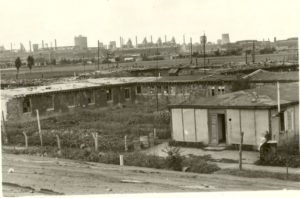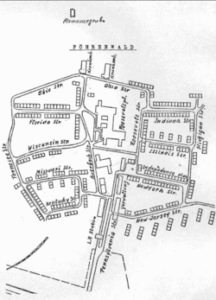…after WWII displaced-person camps were set up for those who were uprooted by the  war? These DP camps were mostly in the occupied countries of Germany, Austria and Italy and divided into responsibilities by the British and American Military. By the beginning of 1947 the number of Jews still in these camps was approximately 210,000.
war? These DP camps were mostly in the occupied countries of Germany, Austria and Italy and divided into responsibilities by the British and American Military. By the beginning of 1947 the number of Jews still in these camps was approximately 210,000.
Immediately after liberation many of them remained in the concentration camps as they had no where to go. Large numbers of Jews lost entire families, houses, possessions and sometimes entire villages were destroyed. Bergen- Belsen CC was turned into a DP camp but 23,000 (90% Jews) died within 3 months following liberation.
Many of these camps were in poor condition, people locked inside with barb wire fences. Inadequate food, clothing, medicine and care resulted in widespread depression and death. In June of 1945, Earl G. Harrison, American delegate to Intergovernmental Committee of Refugees, was sent by President Truman to assess the situation for the displaced persons after the war. Harrison was shocked by what he saw in the DP camps. His report was a ringing condemnation of the way Jewish displaced persons were being treated:
 “Generally speaking […] many Jewish displaced persons and other possibly non-repatriables are living under guard behind barbed-wire fences, in camps of several descriptions (built by the Germans for slave-laborers and Jews), including some of the most notorious of the concentration camps, amidst crowded, frequently unsanitary and generally grim conditions, in complete idleness, with no opportunity, except surreptitiously, to communicate with the outside world, waiting, hoping for some word of encouragement and action in their behalf […] there are many pathetic malnutrition cases both among the hospitalized and in the general population of the camps […] there is a marked and serious lack of needed medical supplies […] many of the Jewish displaced persons, late in July, had no clothing other than their concentration camp garb […] while others, to their chagrin, were obliged to wear German S.S. uniforms…
“Generally speaking […] many Jewish displaced persons and other possibly non-repatriables are living under guard behind barbed-wire fences, in camps of several descriptions (built by the Germans for slave-laborers and Jews), including some of the most notorious of the concentration camps, amidst crowded, frequently unsanitary and generally grim conditions, in complete idleness, with no opportunity, except surreptitiously, to communicate with the outside world, waiting, hoping for some word of encouragement and action in their behalf […] there are many pathetic malnutrition cases both among the hospitalized and in the general population of the camps […] there is a marked and serious lack of needed medical supplies […] many of the Jewish displaced persons, late in July, had no clothing other than their concentration camp garb […] while others, to their chagrin, were obliged to wear German S.S. uniforms…
Beyond knowing that they are no longer in danger of the gas chambers, torture and other forms of violent death, they see – and there is – little change…”
“As matters now stand, we appear to be treating the Jews as the Nazis treated them except that we do not exterminate them. They are in concentration camps in large numbers under our military guard instead of S.S. troops.”
“The first and plainest need of these people is a recognition of their actual status and by this I mean their status as Jews. Most of them have spent years in the worst of the concentration camps. In many cases, although the full extent is not yet known, they are the sole survivors of their families and many have been through the agony of witnessing the destruction of their loved ones. Understandably, therefore, their present condition, physical and mental, is far worse than that of other groups. […] While admittedly it is not normally desirable to set aside particular racial or religious groups from their nationality categories, the plain truth is that this was done for so long by the Nazis that a group has been created which has special needs. Jews as Jews (not members of their own nationality groups) have been more severely victimized than the non-Jewish members of the same or other nationalities.”
Harrison concluded that a stronger effort needed to be made to get the Jews out of the camps, because “they are sick of living in camps.” They simply wanted to rebuild their lives.
– Excerpts from Yad Vashem
https://www.yadvashem.org/articles/general/displaced-persons-camps.html

